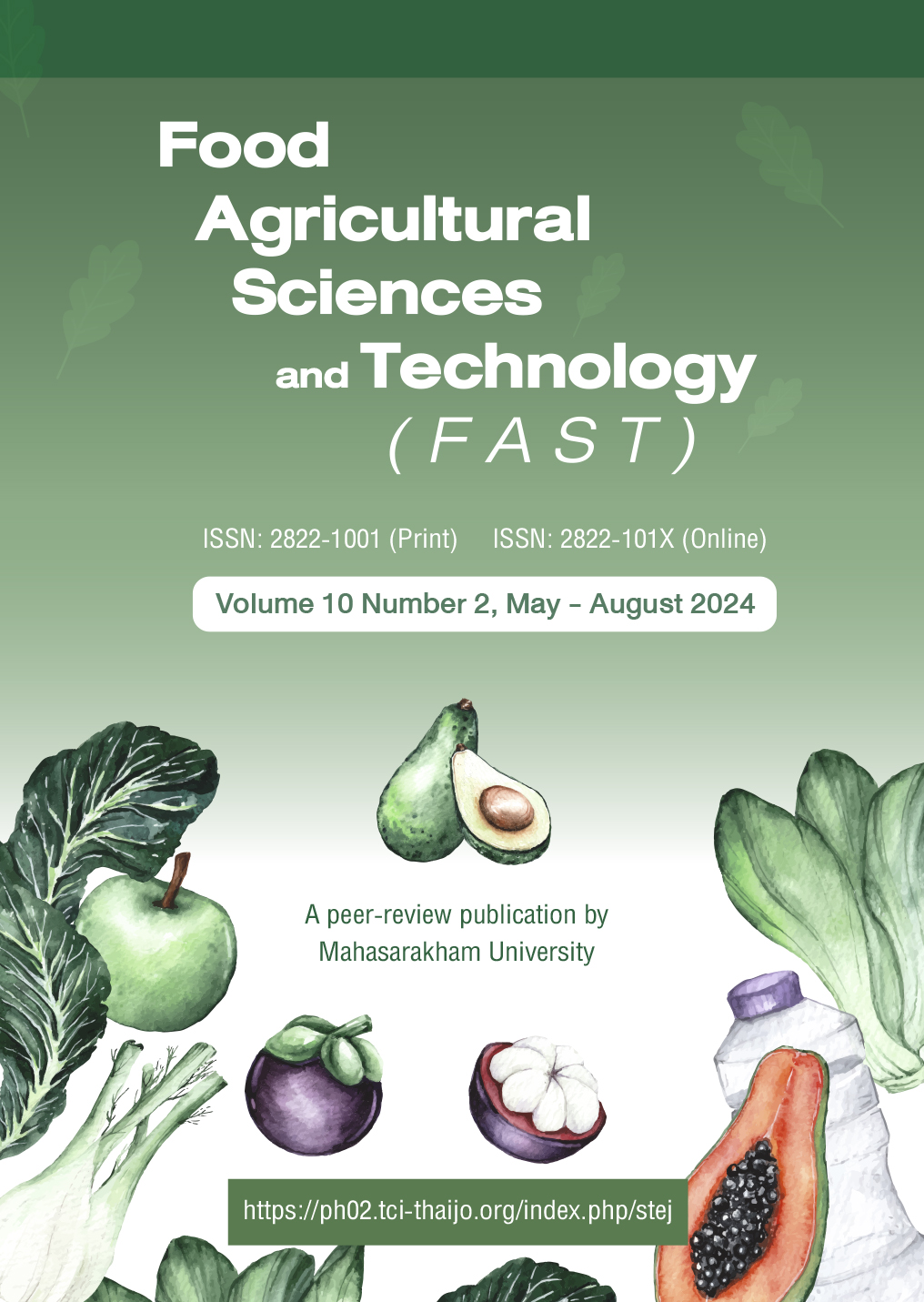Comparisons of digestive enzyme activities and gut performance post feeding with different protein sources between 2g- and 5g-shrimp, Penaeus vannamei
Keywords:
Gut performance, fish meal, soybean meal, growth performance, digestive enzymesAbstract
The objective of this study is to compare digestive enzyme activities between 2 g-shrimp and 5g-shrimp fed with similar diet. Also, it is extended to compare the gut performance including gut passage time (GPT), gut retention time (GRT), gut passage rate (GPR) after feeding with diets of different protein sources. The activities of three digestive enzymes in digestive organs including stomach, hepatopancreas and intestine in the 2 g-shrimp and 5 g-shrimp were compared. Overall, the activities of trypsin, lipase and amylase were found to be higher in the 5 g-shrimp than those of 2 g-shrimp in all three organs tested. In addition, there was no trypsin and lipase activities detected in the intestine of the 2 g-shrimp. The level of lipase activity in the stomach of 2 g-shrimp was 8-times lower than those of the 5 g-shrimp. The feeding experiment was performed to compare the efficiencies of the gut performance in the 2 g-shrimp and 5g-shrimp post feeding with the diets containing different protein sources. Three diet formulae that varied in proportion of fish meal (FM) and soybean meal (SBM) including F1 (30% FM), F2 (10% FM + 28% SBM), and F3 (42% SBM) to result in acceptable total crude protein contents for penaeid shrimp ranging 37% were prepared. The gut performance indicators include gut passage time (GPT), gut retention time (GRT), and gut passage rate (GPR). There were no significant differences among gut performance indicators of the 5 g-shrimp fed with 3 different diets. In contrast, the 2 g-shrimp fed with F3 demonstrated highest GPT, GRT and those fed with F1 revealed highest GPR. Taken together, the results suggest that the digestive functions of the 2 g-shrimp are underdeveloped and the SBM diet retained longer and moved with slow rate in the digestive tract. Further study to demonstrate the adaptability of the 2 g-shrimp to different feed if shrimp has been fed for a long time.
References
Aaqillah-Amr, M. A., Hidir, A., Azra, M. N., Ahmad-Ideris, A. R., Abualreesh, M. H., Noordiyana, M. N., & Ikhwanuddin, M. (2021). Use of pelleted diets in commercially farmed decapods during juvenile stages: A review. Animals, 11, 1761. https://doi.org/10.3390/ ani11061761
AOAC. (2019). Official methods of analysis of the association of official analytical chemists: Official methods of analysis of AOAC international (21st Eds). AOAC.
Areekijseree, M., Engkagul, A., Kovitvadhi, S., Kovitvadhi, U., Thongpan, A., & Rungruangsak-Torrissen, K. (2006). Development of digestive enzymes and in vitro digestibility of different species of phytoplankton for culture of early juveniles of the freshwater pearl mussel, Hyriopsis (Hyriopsis) bialatus Simpson, 1900. Invertebrate Reproduction & Development, 49, 255-262. https://doi.org/10.1080/0792425 9.2006.9652215
Beseres, J.J., Lawrence, A.L.L., & Feller, R.J. (2006). Practical equivalence of laboratory and field measurements of gut passage time in two penaeid shrimp species. Marine Ecology Progress Series, 309, 221-231. https://doi.org/10.3354/meps309221
Galgani, F. G., Benyamin, Y., & Van Wormhoudt, A. (1985). Purification, properties, and immunoassay of trypsin from the shrimp Penaeus japonicus. Comparative Biochemistry and Physiology B, 81, 447-452. https://doi.org/10.1016/0305- 0491(85)90340-2
Gamboa-delgado, J., Molina-poveda, C., & Cahu, C. (2003). Digestive enzyme activity and food ingesta in juvenile shrimp Litopenaeus vannamei (Boone, 1931) as a function of body weight. Aquaculture Research, 34, 1403-1411. https://doi.org/10.1111/ j.1365-2109.2003.00959.x
McGaw, I. J., & Curtis, D. L. (2013). A review of gastric processing in decapod crustaceans. Journal of Comparative Physiology B, 183, 443-465. https://doi.org/10.1007/ s00360-012-0730-3
Rungruangsak-Torrissen, K. (2007). Digestive efficiency, growth, and qualities of muscle and oocyte in Atlantic salmon (Salmo salar L.) fed on diets with krill meal as an alternative protein source. Journal of Food Biochemistry, 31, 509-540. https://doi.org/10.1111/j.1745- 4514.2007.00127.x
Shao, J., Zhao, W., Liu, X., & Wang, L. (2018). Growth performance, digestive enzymes, and TOR signaling pathway of Litopenaeus vannamei are not significantly affected by dietary protein hydrolysates in practical conditions. Frontiers in Physiology, 9, 1-8. https://doi. org/10.3389/fphys.2018.00998
Sullivan, D. & Carpenter, D. (1993). Method of analysis for nutrition labeling. AOAC International.
Štrus, J., Žnidaršič, N., Mrak, P., Bogataj, U., & Vogt, G. (2019). Structure, function, and development of the digestive system in malacostracan crustaceans and adaptation to different lifestyles. Cell and Tissue Research, 377, 415-443. https://doi. org/10.1007/s00441-019-03056-0
Versaw, W. K., Cuppett, S. L., Winters, D. D., & Williams, L. E. (1989). An improved colorimetric assay for bacterial lipase in nonfat dry milk. Journal of Food Science, 54, 1557-1558. https:// doi.org/10.1111/j.1365-2621.1989. tb05159.x
Downloads
Published
How to Cite
Issue
Section
License
Copyright (c) 2024 Food Agricultural Sciences and Technology

This work is licensed under a Creative Commons Attribution-NoDerivatives 4.0 International License.






